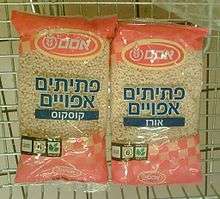Ptitim
 | |
| Alternative names | Israeli couscous, Jerusalem couscous, pearl couscous |
|---|---|
| Type | Pasta |
| Course | Side dish |
| Place of origin | Israel |
| Creator | Osem |
|
| |
Ptitim (Hebrew: פתיתים) is a type of toasted pasta shaped like rice-grains or little balls developed in Israel in the 1950s when rice was scarce. Outside Israel it is sometimes marketed as Israeli couscous or Jerusalem couscous.[1] In Israel it became known as "Ben-Gurion rice" (Hebrew: אורז בן-גוריון órez Ben-Gurion).
History

Ptitim was invented during the austerity period in Israel (from 1949 to 1959).[1] Israel's first prime minister, David Ben-Gurion, asked Eugen Proper, one of the founders of the Osem food company, to quickly devise a wheat-based substitute to rice.[1] Consequently, it was nicknamed "Ben-Gurion's rice" by the people.[1] The company took up the challenge and developed ptitim, which is made of hard wheat flour and toasted in an oven.[1] The product was instantly a success, after which ptitim made in the shape of small, dense balls (which the company termed "couscous") was added to the original rice-shaped ptitim.
Preparation
Ptitim is popular among Israeli children, who eat it plain, or mixed with fried onion and tomato paste.[1] Ptitim are now produced in ring, star, and heart shapes for added appeal.[1] For health conscious consumers,[2] there are also whole-wheat and spelt flour ptitim.[1]
While considered a children's food in Israel, ptitim is sometimes treated as an ingredient for "trendy delicacies".[1] In the United States, it can be found on the menus of contemporary American chefs, and can be bought in gourmet markets.[3]
Ptitim can be used in many different types of dishes, both hot and cold. They retain their shape and texture even when reheated, and they do not clump together.[3]
Commonly, ptitim are prepared with sautéed onions or garlic (vegetables, meat, chicken or sausages can also be added); the ptitim are then added, and fried for a short time before adding water.[1] Ptitim can also be used as a substitute for pasta or rice. They can also go in soup, can be baked, served in a pie, or made as a risotto.[1] American chef Charlie Trotter has produced a recipe for ptitim with spinach, artichoke, and Kalamata olives.[1]
Similar products
Pearl-shaped ptitim is similar to the Levantine pearled couscous known as maftoul or mograbieh in Palestine, Jordan, Syria and Lebanon.[4] It is also similar to the Kabyle Abazine and the Sardinian Fregula. Rice-shaped ptitim are similar to orzo.[4] Ptitim is not the same as Mograbia (aka Maftoul, Pearl Couscous etc.), though the two can be used similarly. Mograbia is a coated couscous; Ptitim is an extruded paste. Note as well that the word "Maftoul" is sometimes incorrectly used in America to refer to Israeli couscous.
See also
References
- 1 2 3 4 5 6 7 8 9 10 11 12 Doram Gaunt. "Ben-Gurion's Rice". Haaretz. Retrieved 2012-06-05.
- ↑ Sharon Wrobel. "Half of Israeli households buy low-fat products". The Jerusalem Post. Retrieved 2012-06-05.
- 1 2 Faye Levy. "Petit ptitim". The Jerusalem Post. Retrieved 2012-06-05.
- 1 2 "Israeli Couscous". GourmetSleuth.com. Retrieved 2012-06-05.
External links
| Wikimedia Commons has media related to Ptitim. |